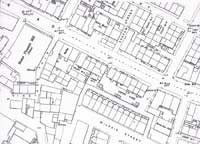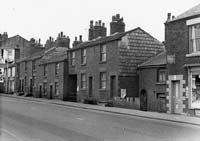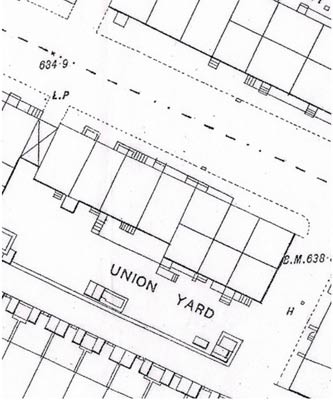Domestic Building 1899 – 1970
Prior to the turn of the 20th Century, unplanned and more or less unregulated.
Speculative Domestic building continued, sanitation had improved, but by modern standards remained rudimentary. The unsatisfactory sharing of lavatories continued, flush lavatories were uncommon and the 'Night Soil' man was very much in evidence.
Churches, chapels continued to be constructed; however the conventional east/ west orientation had long since been abandoned in line with economic expediency. The majority of these ecclesiastical constructions were funded by employers, wealthy parishioners and were generally of a slightly elevated quality to the surrounding housing. Education had improved though illiteracy was not unknown, or for that matter uncommon.
Churches and chapels were internally frequently decorated with instructive and unhelpful moral quotes from the scriptures; some years ago, in Leeds I noted one ironic quotation which was 'Look ye to the works of the Lord'. The chapel was adjacent to a row of back-to-back slums.
The fear of God was instilled into the population and hard work was seen as the pre-requisite path to eternity and heaven.
Much has been written about the Poor Laws and the merciless Workhouse so I will not elaborate here and allow the reader to investigate. I will return to the 'Workhouse' in a future essay…
As I have already stated, Oldham did not support many altruistic or enlightened employers, the majority of the industries and mills were small to middle sized and though cotton was king, the manufacture of machinery and engineering was a not inconsiderable part of the local economy.
It is not until after the Great War, that circumstances were to improve. That the War was a disaster both in terms of economics and manpower is to understate the obvious.
Grandiose 'statement' buildings had been constructed from circa 1830 to the present, and Oldham embraced many fine public and civic buildings and during this time was relatively prosperous, although the anticipated 'trickle down' effect was mysteriously absent; the worker had been studiously ignored.

Link to map
|
I would now like to examine a very small neighbourhood in Oldham which was developed from the mid 19th century, that of Townfield and Lees Road, Oldham. |
Union Yard
This drawing encompasses 94 to 106 Lees road and was broadly opposite the fondly remembered, 'Robin Hood' public house. These buildings were of brick with sandstone lintels to their door and sash window openings.
The three to the right 102 – 106 are of the back-to-back, over and under construction as can be seen from this photo and diagram.

Frontage on Lees Road
|
|
In 1946 three families would have shared each of these buildings - the buildings 94 to 100 were of the over and under construction. So at full occupancy at least 17 families would have shared this one-yard. However, it is instructive to count the privies – seven… and I cannot see plumbing… Much used in this area was the infamous 'tippler' lavatory.
These buildings were still occupied as late as 1966, and were finally demolished in c.1969. I would like to thank the late Mr. Peter Kenny whose parents lived at 100 Lees Rd., for his assistance.
All over Oldham from the mid 19th century similar buildings were constructed and notably (and notoriously) in the St Mary's area until they were finally removed in the slum clearances of the1960's.
Oldham retains some stone domestic buildings but unfortunately much of the building quality stone had to be 'imported' from Saddleworth and the areas around Marsden and Mossley, which was better served with the establishment of the railways (and earlier by the canals).
The Coming of the Council House
In 1884 following the abuses of earlier legislation a Royal Commission on Housing was appointed. One of its observations was.
There can be no doubt but that the houses are often built of the commonest materials and with the worst workmanship, and altogether unfit for the people to live in,especially if they are a little rough in their ways… It is quite certain that the working classes are largely housed in dwellings, which would be unsuitable even if they were not overcrowded
Later, it was observed;
It is totally impossible that private enterprise, philanthropy and charity cannot keeppace with modern demands
Finally the penny had dropped. However, it was too late for families living in existing insanitary, overcrowded Courts.
Though many councils' and speculative builders were stymied by these acts and laws, they were often circumvented, nevertheless it was a beginning.
It was not until the end of the First World War and the Russian Revolution of 1917 that fearing possible civil insurrection the government of Lloyd George commissioned the Tudor Walters report (Chaired by Sir John Tudor Walters
MP and included the reformist Raymond Unwin.)
The report was published in 1918 and was recognised as 'Revolutionary'. It recommended building densities, not more than 12 to an acre; a terrace should be limited to 8 homes, in a 'variety' of types, uniform road widths, and importantly following the publishing in 1919 of 'The Housing Manual';
Every house was to have an internal WC positioned off the back lobby and was to have a bath.
The Tudor Walters report was followed by the Town Planning Act, usually referred to as the 'Addison Act'. (Incidentally Christopher Addison was the first Minister of Health.)
In my opinion this action was too late, neglectful politicians had already done irreparable damage…
Finally the age of the Council House had arrived. Which we will examine in
the next digest…
Contributed by Alex Balmforth
April 2014
Selected Sources:
Alec Clifton Taylor, the Pattern of English Building
Building the West Riding, Lynne F Pearson
Stephen Methusius, Roger Dixon, Victorian Architecture
Aneurin Bevan, In Place of Fear
Alex Balmforth, various papers and studies.



